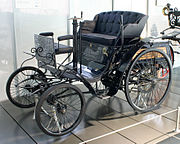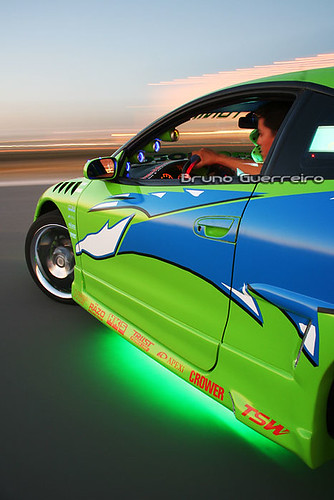
An automobile (also motor car or simply car) is a wheeled passenger vehicle that carries its own motor. Most definitions of the term specify that automobiles are designed to run primarily on roads, to have seating for one to eight people, to typically have four wheels, and to be constructed principally for the transport of people rather than goods.However, the term is far from precise.
As of 2002, there were 590 million passenger cars worldwide (roughly one car for every eleven people).
Vehicles that can be considered automobiles were demonstrated as early as 1769, and 1885 marked the introduction of gasoline powered internal combustion engines. Automotive history is generally divided into a number of eras based on the major design and technology shifts. Although the exact boundaries of each era can be hazy, scholarship has defined them as follows:
| Automobile history eras | |||||||||||||||||||||||||||||||||||||||||||||||||||||||||||||||||||||||||||||||||||||||||||||||||||||||||||||||||||||||
| 1890s | 1900s | 1910s | 1920s | 1930s | 1940s | 1950s | 1960s | 1970s | 1980s | 1990s | 2000s | ||||||||||||||||||||||||||||||||||||||||||||||||||||||||||||||||||||||||||||||||||||||||||||||||||||||||||||
| Veteran | Brass or Edwardian | Vintage | Pre-War | Post-War | Modern | ||||||||||||||||||||||||||||||||||||||||||||||||||||||||||||||||||||||||||||||||||||||||||||||||||||||||||||||||||
| Classic | |||||||||||||||||||||||||||||||||||||||||||||||||||||||||||||||||||||||||||||||||||||||||||||||||||||||||||||||||||||||
Eras of Invention


Steam-powered self propelled vehicles were devised in the late 17th century. A Flemish priest, Ferdinand Verbiest, was thought to have demonstrated in 1678 a small steam car to the Chinese emperor,yet there is no evidence for it. Nicolas-Joseph Cugnot successfully demonstrated such a vehicle on a real scale as early as 1769. Cugnot's invention initially saw little application in his native France, and the center of innovation passed to Great Britain, where Richard Trevithick was running a steam-carriage in 1801. Such vehicles were in vogue for a time, and over the next decades such innovations as hand brakes, multi-speed transmissions, and improved speed and steering were developed. Some were commercially successful in providing mass transit, until a backlash against these large speedy vehicles resulted in passing a law, the Locomotive Act, in 1865 that self-propelled vehicles on public roads in the United Kingdom must be preceded by a man on foot waving a red flag and blowing a horn. This effectively killed road auto development in the UK for most of the rest of the 19th century, as inventors and engineers shifted their efforts to improvements in railway locomotives. The law was not finally repealed until 1896 although the need for the red flag was removed in 1878.


The first automobile patent in the United States was granted to Oliver Evans in 1789. Later, in 1805, Evans demonstrated his first successful self-propelled vehicle, which not only was the first automobile in the USA but was also the first amphibious vehicle, as his steam-powered vehicle was able to travel on wheels on land and via a paddle wheel in the water.
Belgian born Etienne Lenoir made a car with an internal combustion engine around 1860, though it was driven by coal-gas. His experiment lasted for 7 miles, but it took him 3 hours; He would have been faster on foot. Lenoir never tried experimenting with cars again. The French claim that a Deboutteville-Delamare was successful, and the French celebrated the 100th birthday of the car in 1984.
About 1870, in Vienna, capital of Austria (then, the Austro-Hungarian Empire), inventor Siegfried Marcus put an internal liquid fuel engine on a simple handcart which made him the first man propelling a vehicle by means of gasoline. Today, this car is well known as “The first Marcus Car”.
In 1883, Marcus got a patent for a low voltage ignition of the magneto type - in Germany. This design was used for all further engines and, of course, the famous “Second Marcus Car” of 1888/89. This ignition in conjunction with the “rotating brush carburetor” made the “Second Car”'s design very innovative.
It is generally acknowledged that the first automobiles with gasoline powered internal combustion engines were completed almost simultaneously by several German inventors working independently: Karl Benz built his first automobile in 1885 in Mannheim. Benz was granted a patent for his automobile on January 29, 1886 and began the first production of automobiles in 1888. Soon there after, Gottlieb Daimler and Wilhelm Maybach in Stuttgart in 1889 designed a vehicle from scratch to be an automobile rather than a horse carriage fitted with an engine. They also were inventors of the first motor bike in 1886. Much earlier, above mentioned Siegfried Marcus in Vienna built his crude First Car (engine on handcart) around 1870. His Second Car with four seats may have run only in 1888-1889, thus after Benz - and Marcus never applied for a general patent for his liquid-fuel wheelers, only for his Second's ignition. One of the first four wheel petrol-driven automobiles built in Britain came in Birmingham in 1895 by Frederick William Lanchester who also patented the disc brake.

0 comments:
Post a Comment